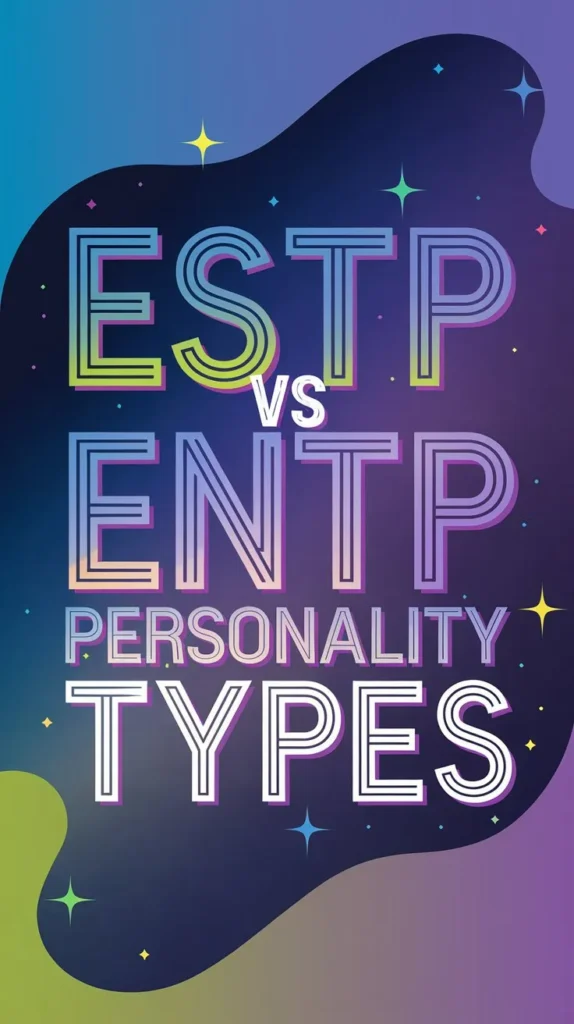You’re likely familiar with the charismatic and adventurous types who always seem to be on the go – but can you tell the difference between an ESTP and an ENTP? At first glance, they may appear similar, but as you get to know them, subtle distinctions emerge.
One prioritizes action and tangible results, while the other thrives on ideas and possibilities. Understanding these nuances can help you better navigate relationships and collaborations with these dynamic personalities. But what exactly sets them apart, and how can you identify which type you’re dealing with?
In a Nutshell

- ESTPs prioritize action and quick results, whereas ENTPs focus on exploring ideas and possibilities, making them distinct in their approach to problem-solving.
- ESTPs are driven by sensory experiences and social interactions, while ENTPs are motivated by intellectual pursuits and uncovering new insights.
- ESTPs tend to be more impulsive and action-oriented, whereas ENTPs are more cerebral and analytical in their decision-making processes.
- ESTPs rely on empirical evidence and practical applications, whereas ENTPs seek theoretical understanding and underlying principles.
Understanding ESTP Personality Traits
You’re likely familiar with the adventurous and action-oriented nature of ESTPs, who thrive in fast-paced environments and live for the thrill of the moment.
This personality type is known for their bold and spontaneous approach to life, always seeking new experiences and challenges.
ESTP strengths include their exceptional adaptability, quick thinking, and natural charisma, which enables them to effortlessly connect with others.
They’re also highly resilient and can bounce back from setbacks with ease.
However, like any personality type, ESTPs also have their weaknesses.
They can be impulsive and reckless, leaping into situations without considering the consequences.
Their tendency to act on instinct can sometimes lead to reckless decisions, and their constant need for excitement can make it difficult for them to settle down or commit to long-term plans.
Additionally, ESTPs may struggle with emotional depth, finding it challenging to explore their own feelings or empathize with others.
Despite these weaknesses, ESTPs are undeniably energetic and engaging, and their strengths often make them a valuable asset in social and professional settings.
ENTP Personality Characteristics Defined
ENTPs are entrepreneurial free thinkers, constantly generating innovative ideas and exploring uncharted territories, as they thrive in an atmosphere of intellectual freedom and flexibility. You’re likely an ENTP if you’re drawn to unconventional solutions and love to challenge traditional thinking. Your creative freedom is essential, and you crave the autonomy to pursue your interests without constraints.
As an ENTP, you’re naturally curious and enjoy exploring complex ideas and systems. You’re a master of finding connections between seemingly unrelated concepts and spotting patterns that others might miss.
Your innovative thinking allows you to come up with novel solutions to problems, making you a valuable asset in brainstorming sessions or when tackling complex projects.
ENTPs are also known for their adaptability and love for debate. You’re not afraid to argue your point of view, and you’re open to changing your stance if presented with compelling evidence.
Your enthusiasm for exploring new ideas and perspectives makes you a fascinating conversationalist and a valuable member of any team.
Action-Oriented Vs Cerebral Approaches
ESTPs and ENTPs diverge in their approach to problem-solving, with ESTPs favoring action-oriented tactics that get results quickly, whereas ENTPs tend to adopt a more cerebral approach, analyzing possibilities and exploring abstract ideas.
As you navigate your own problem-solving style, consider whether you’re more inclined to take spontaneous decisions, relying on your instincts to guide you, or if you prefer to engage in thoughtful planning, weighing the pros and cons before making a move.
ESTPs often prioritize action over analysis, trusting their gut to lead them to a solution.
In contrast, ENTPs tend to intellectualize, dissecting a problem from multiple angles before deciding on a course of action.
When faced with a challenge, ask yourself: do you charge forward, relying on your adaptability to overcome obstacles, or do you step back, examining the issue from a more theoretical perspective?
Understanding your natural inclination can help you identify which approach works best for you – and whether you’re more likely to identify as an ESTP or an ENTP.
Thrill-Seeking Vs Idea Generation
As you navigate the complexities of problem-solving, your approach to excitement and novelty can also serve as a distinguishing factor between ESTP and ENTP personalities.
While both types share a thirst for adventure, they differ in their motivations and expressions.
What drives your thrill-seeking nature?
Are you a risk taker who lives in the moment, craving immediate action and sensory experiences (ESTP)?
Or do you generate ideas rapidly, exploring abstract connections and possibilities, often jumping from one mental thread to another (ENTP)?
Do you prioritize the rush of adrenaline and the satisfaction of overcoming physical challenges (ESTP), or the intellectual thrill of solving complex puzzles and uncovering new insights (ENTP)?
Are you an adventure craver who seeks out new experiences and social interactions (ESTP), or a conceptual explorer who’s more focused on generating innovative ideas and theories (ENTP)?
Does your enthusiasm stem from the excitement of the unknown, or the joy of mental exploration and debate?
Social Interaction and Communication
When interacting with others, you’ll notice that ESTPs and ENTPs have distinct approaches to social interaction and communication.
You’ll find that ESTPs tend to focus on verbal cues and direct language, whereas ENTPs are more attuned to nonverbal signals and abstract communication styles.
Understanding these differences can help you navigate conversations with these types more effectively.
Verbal Vs. Nonverbal Cues
ENTps tend to focus more on verbal cues, relying on the actual words being spoken, whereas ESTPs are more attuned to nonverbal signals, like body language and tone of voice. This difference in focus can greatly impact their communication styles and relationships.
ENTps might interrupt or finish your sentences, as they’re more focused on the verbal exchange.
ESTPs, on the other hand, will likely maintain strong eye contact, using it to gauge your interest and engagement.
ENTps might be more prone to misinterpreting nonverbal cues, while ESTPs are more likely to pick up on subtle body language signals.
ESTPs tend to use more expressive body language, such as gestures and facial expressions, to convey their emotions.
When interacting with an ESTP, you might notice they’re more likely to mirror your body language, creating a sense of rapport and connection.
Direct Vs. Abstract Language
In social interactions, ENTps tend to employ abstract language, using theoretical concepts and hypothetical scenarios to explore ideas, whereas ESTPs opt for direct language, conveying concrete facts and practical applications.
This difference in language style can profoundly impact your conversations with these personalities.
When interacting with an ENTp, you may find yourself traversing complex ideas and theoretical frameworks, which can be fascinating but also lead to language barriers.
On the other hand, ESTPs’ direct language helps maintain a smooth conversational flow, as they focus on tangible facts and real-world implications.
As you engage with these personalities, pay attention to their language preferences.
With ENTps, be prepared to explore abstract concepts and consider multiple perspectives.
With ESTPs, expect a more straightforward exchange of information, centered on practical applications.
By adapting to their language styles, you can foster more effective communication and build stronger connections.
Remember, understanding these differences can help you traverse potential language barriers and create a more harmonious conversational flow.
Logical Reasoning and Decision-Making
When it comes to logical reasoning and decision-making, you’ll find that ESTPs and ENTPs share some similarities, but also have distinct differences.
You’ll notice that both types are adept at analyzing data points and identifying patterns.
However, the key difference lies in how quickly they weigh their options and make a decision, with ESTPs typically being more impulsive and ENTPs more likely to take their time.
Analyzing Data Points
ESTPs and ENTPs both excel at analyzing data points, but their approaches to logical reasoning and decision-making differ substantially.
You might notice that ESTPs are more focused on identifying concrete data patterns, whereas ENTPs are more interested in exploring the underlying trends and systems that drive those patterns.
Some key differences to ponder:
ESTPs focus on practical applications: They’re concerned with how data can be used to solve real-world problems or achieve specific goals.
ENTPs seek theoretical understanding: They’re driven to uncover the underlying principles and mechanisms that govern data patterns and trends.
ESTPs rely on empirical evidence: They trust data that’s backed by concrete, tangible proof.
ENTPs weigh alternative perspectives: They’re open to exploring unconventional ideas and hypothetical scenarios.
ESTPs prioritize efficiency and speed: They’re focused on finding the most direct path to a solution, whereas ENTPs are more willing to take their time to explore different scenarios.
Weighing Options Quickly
ENTPs and ESTPs approach logical reasoning and decision-making with distinct styles, which become apparent when weighing options quickly.
When faced with a decision, ENTPs tend to engage in spontaneous deliberation, rapidly cycling through pros and cons, and exploring different perspectives.
This process can sometimes lead to a sense of analysis paralysis, as they struggle to commit to a single option.
In contrast, ESTPs tend to be more action-oriented, often relying on their instincts to guide their decision-making process.
They’re more likely to trust their gut feeling and make a quick decision, rather than getting bogged down in lengthy decision cycles.
This doesn’t mean ESTPs don’t consider options carefully, but they’re more focused on taking action than exploring every possible scenario.
As you consider your own approach to decision-making, ask yourself: do you tend to deliberate extensively, or do you trust your instincts and act quickly?
This self-awareness can help you better understand your personality type and make more effective decisions.
Emotional Intelligence and Empathy
Handling emotions, both yours and others’, is a delicate dance that can make or break relationships, and understanding how ESTPs and ENTPs navigate this domain can provide valuable insights into their interpersonal dynamics.
You might wonder, how do these two personality types approach emotional intelligence and empathy?
ESTPs tend to have a more superficial Emotional Affinity, meaning they’re great at reading surface-level emotions but might struggle to probe further into complexities. They’re action-oriented and focus on finding solutions rather than indulging in emotional discussions.
ENTPs, on the other hand, have a more theoretical approach to emotions, often analyzing and intellectualizing feelings rather than directly experiencing them. This can make them appear detached or insensitive, but they’re actually trying to understand the underlying mechanisms.
ESTPs are more likely to be empathetic in the moment, offering immediate support and comfort, whereas ENTPs might take time to process and respond.
ENTPs tend to be more self-aware of their emotions, but this introspection can sometimes lead to emotional turmoil.
Both types can struggle with emotional intimacy, but ESTPs might be more willing to open up in the right circumstances.
Conflict Resolution Strategies
When it comes to conflict resolution, you’ll notice that ESTPs and ENTPs take different approaches.
ESTPs prioritize quick fixes, focusing on finding a solution that works in the moment, whereas ENTPs are more inclined to analyze the issue deeply, seeking a more thorough understanding.
As you explore these strategies, you’ll also observe that ESTPs often rely on emotional appeals, while ENTPs prefer to rely on logic to resolve conflicts.
Quick Fixes Vs. Deep Analysis
ESTPs often prioritize quick fixes, seeking to resolve conflicts rapidly and move on, whereas ENTPs tend to plunge into deep analysis, dissecting the issue to understand its underlying causes.
When you’re trying to resolve a conflict, do you quickly look for a solution to get things back on track, or do you take a step back to examine the root of the problem?
ESTPs: Focus on finding a quick solution to restore order and stability. They might overlook underlying issues to get things moving again.
ENTPs: Engage in systematic thinking to identify the root cause of the conflict. They’re more concerned with understanding the problem than finding a quick fix.
Impulse control: ESTPs tend to act on impulse, while ENTPs take their time to analyze the situation before responding.
Analysis vs. Action: ENTPs prioritize analysis, while ESTPs focus on taking action.
Conflict resolution goals: ESTPs aim to restore order, while ENTPs seek to understand the underlying dynamics of the conflict.
Emotional Appeals Vs. Logic
As you navigate conflict resolution, you’ll likely encounter situations where emotional appeals or logical arguments come into play, and your approach can substantially impact the outcome.
ESTPs and ENTPs often differ in their approach to resolving conflicts, which can be attributed to their distinct personalities.
ESTPs tend to rely on emotional appeals to resolve conflicts.
They’re naturally charismatic and can create heartfelt connections with others, using their charm to diffuse tense situations.
However, this approach can sometimes border on emotional manipulation, which may not always be effective in the long run.
ENTPs prefer to rely on logical arguments to resolve conflicts.
They’re drawn to objective analysis and enjoy exploring different perspectives, which can lead to more rational and sustainable solutions.
When dealing with conflicts, it’s crucial to be aware of your approach and the potential impact it may have on the outcome.
Long-Term Planning and Organization
You’ll likely find that organizing long-term plans feels like a necessary evil, something you’d rather put off in favor of more exciting pursuits. However, as an ESTP or ENTP, you know that goal setting and time management are vital for achieving your objectives.
ESTPs tend to focus on short-term goals, breaking them down into smaller, actionable steps. They’re excellent at adapting to changing circumstances and adjusting their plans accordingly.
ENTPs, on the other hand, are more focused on the big picture, often coming up with innovative solutions to complex problems. They’re prone to getting bogged down in details, but their creativity shines when it comes to finding novel approaches.
ESTPs are more likely to stick to a plan once it’s in place, even if it becomes tedious or boring. ENTPs, by contrast, get restless if they’re stuck in a routine for too long and may abandon a plan if it no longer holds their interest.
ESTPs prioritize efficiency and practicality in their planning, while ENTPs are more concerned with exploring new ideas and possibilities.
Both types can struggle with procrastination, but ESTPs are more likely to push through and get things done, even if they’re not particularly enthusiastic about the task.
Career Choices and Lifelong Pursuits
Your ideal career is one that offers a mix of excitement, challenge, and autonomy, allowing you to pursue lifelong passions and interests that align with your values and strengths.
As an ESTP or ENTP, you crave freedom to explore and express yourself in various creative outlets. You’re drawn to careers that offer flexibility and adaptability, allowing you to pivot when opportunities arise.
Entrepreneurial ventures often appeal to your adventurous spirit, as you enjoy taking calculated risks and pushing boundaries. You’re naturally curious and enjoy solving complex problems, making you a great fit for careers in technology, innovation, or the arts.
Your ideal work environment is fast-paced, dynamic, and collaborative, with a focus on brainstorming and idea generation. Whether you’re an ESTP or ENTP, you’re driven to make a meaningful impact and leave a lasting legacy.
Frequently Asked Questions
Can ESTPS and ENTPS Be Good Romantic Partners?
You might wonder, can ESTPs and ENTPs make good romantic partners? They can, if you’re both willing to work on emotional intimacy and conflict resolution, as their opposing strengths can create a balanced and exciting dynamic.
Do ESTPS and ENTPS Make Good Team Leaders?
You’ll thrive as a team leader if you leverage your natural charisma to motivate others, focusing on leadership strengths like adaptability and decisiveness to foster positive team dynamics and drive results.
How Do ESTPS and ENTPS Handle Criticism and Feedback?
When receiving criticism and feedback, you’ll likely notice that you either react defensively or see it as a growth opportunity.
Can ESTPS and ENTPS Be Introverted or Ambiverted?
You might assume that ESTPs and ENTPs are always extroverted, but that’s not true. Introverted stereotypes don’t apply here, and social energy myths can be misleading – both types can be introverted or ambiverted, with varying energy levels.
Are ESTPS and ENTPS More Prone to Anxiety or Depression?
You might wonder, are you more prone to anxiety or depression? Both ESTPs and ENTPs can experience anxiety triggers, but they often cope with them differently; ENTPs might intellectualize, while ESTPs may act impulsively, and depression coping mechanisms vary, too.












James Green is a seasoned psychologist specializing in narcissism and other personality and relationship issues. With a passion for helping others understand and navigate their own personality traits and relationships, James shares his insights and expertise on his blog, Personality Diaries. Connect with him on Pinterest and Instagram for regular updates and insights.



